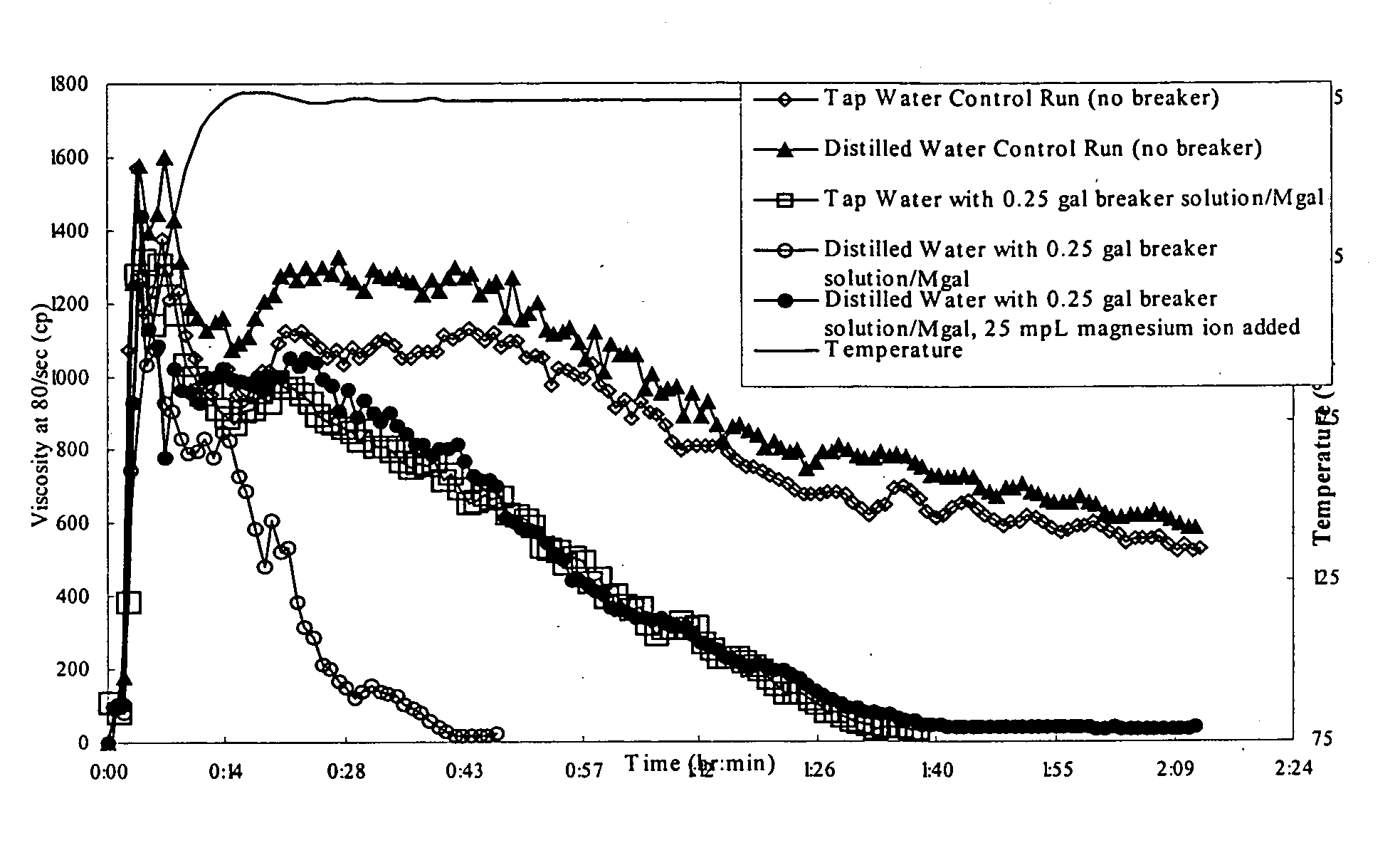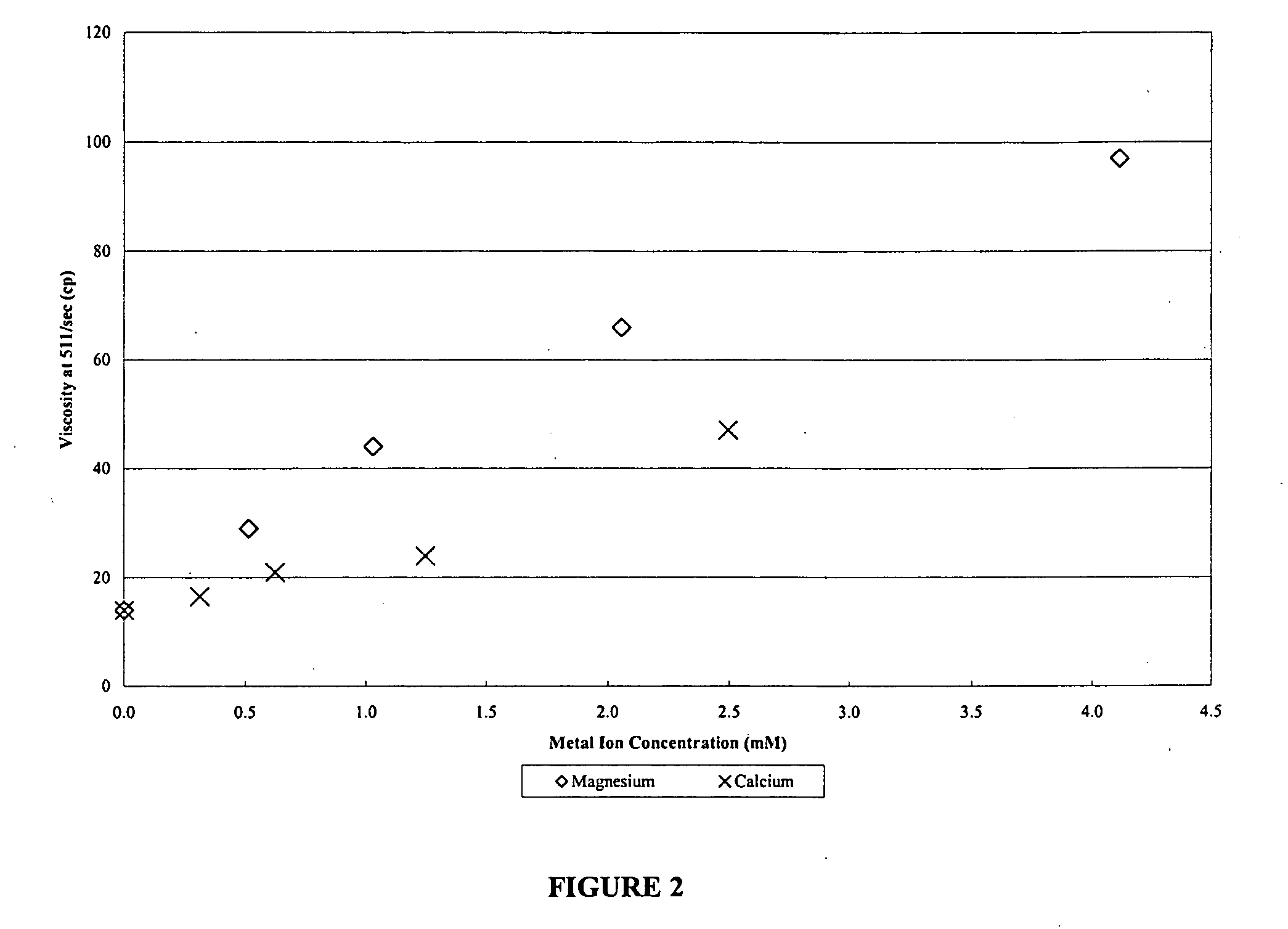Controlling chlorite or hypochlorite break rate of well treatment fluids using magnesium or calcium ions
a well treatment fluid and chlorite technology, applied in the direction of sealing/packing, chemistry apparatus and processes, wellbore/well accessories, etc., can solve the problems of affecting the treatment effect, and affecting the quality of the treatment fluid, so as to increase the viscosity and break the viscosity
- Summary
- Abstract
- Description
- Claims
- Application Information
AI Technical Summary
Benefits of technology
Problems solved by technology
Method used
Image
Examples
example 1
[0060] In one test, Duncan tap water and deionized water were used in viscosified control fluids for static break tests using sodium chlorite. The sodium chlorite was added to the fluids, which caused a rapid viscosity loss to the sample with deionized water as compared to the sample with Duncan tap water.
[0061]FIG. 1 demonstrates the results of static break tests performed at 270° F., comparing the use of various waters to make up the guar gel fluids, including Duncan tap water (sometimes referred to as “DTW”) and fresh water field samples from Browning, Tex.; Haynes, La.; and Springhill City, La. The degree of break is reported as a percentage of the ratio of sample viscosity with sodium chlorite to sample viscosity without sodium chlorite, as measured two hours after the addition of the sodium chlorite at a shear rate of 511 / second. For Duncan tap water, final viscosity of sample containing sodium chlorite was 77 centipoises (“cp”) and viscosity of sample without sodium chlorite...
example 2
[0063] Table 3 shows the break test results to investigate the effect of individual Duncan tap water components added to distilled water. The fluid formulation comprises 80 lb guar per 1,000 gallons of the specific water to be tested, 3 gallons of the sodium thiosulfate solution per 1,000 gallons of water, 3 gallons of the 25% w / w NaOH per 1,000 gallons water, and 0.25 gallon of the sodium chlorite solution per 1,000 gallons of water.
[0064] As evident by Table 3, both calcium and magnesium stabilize the fluid (or slow break rate), whereas other components of Duncan tap water, bicarbonate and sulfate showed little effect on break rate. Further, iron (III), another possible difference between the waters, appears to significantly accelerate break rate.
TABLE 3Distilled Water (With DTW Components Added) Static Break Test at 275° F. (2 hours).Sample No.12345678Water:Dist + 50 mg / LDist + 200 mg / LDist + 100 mg / LDist + 50 mg / LDist + 25 Mg / LDist + 20 mg / LCa2+ + 25 mg / LDTWDistHCO3−SO42−Ca2+...
example 3
[0065]FIG. 2 illustrates the static break test results performed on fluids when concentrations of magnesium and calcium ions were varied. Fluid formulation was 80 lb guar per 1,000 gallons of water, 3 gallon of the sodium thiosulfate solution per 1,000 gallons of fluid, 3 gallons of 25% w / w NaOH solution per 1,000 gallons of fluid, and 0.25 gallons of sodium chlorite solution per 1,000 gallons gel fluid, which were individually mixed samples. In this test series, fluid samples were placed into pressure stable cells and heated to 275° F. for two hours, and then cooled. Fluid viscosity was then recorded.
TABLE 4aStatic Break Test at 275° F. (2 hours) using DTW or distilled water (“Dist”) and addedMg2+ and Ca2+.Sample No.12345678Dist + 12.5 mg / LDist + 25 mg / LDist + 50 mg / LDist + 100 mg / LDist + 12.5 mg / LDist + 25 mg / LDTWDistMg2+Mg2+Mg2+Mg2+Ca2+Ca2+Viscosity at 511 / sec (cp)Initial118113115116116116118117(74° F.)Final56142944669716.521(72° F.)pHInitial11.711.8311.7711.711.6511.611.6511.6...
PUM
| Property | Measurement | Unit |
|---|---|---|
| Temperature | aaaaa | aaaaa |
| Temperature | aaaaa | aaaaa |
| Time | aaaaa | aaaaa |
Abstract
Description
Claims
Application Information
 Login to View More
Login to View More - R&D
- Intellectual Property
- Life Sciences
- Materials
- Tech Scout
- Unparalleled Data Quality
- Higher Quality Content
- 60% Fewer Hallucinations
Browse by: Latest US Patents, China's latest patents, Technical Efficacy Thesaurus, Application Domain, Technology Topic, Popular Technical Reports.
© 2025 PatSnap. All rights reserved.Legal|Privacy policy|Modern Slavery Act Transparency Statement|Sitemap|About US| Contact US: help@patsnap.com



